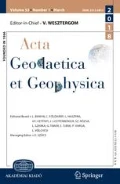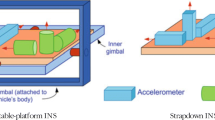Abstract
Traditional torque type gravity gradiometer has an important pole in gravity gradient measurements, while it is relatively inefficient and with the precision of about 1 E mainly caused by the static operating mode. In this paper, we develop an improved torque type gravity gradiometer to improve the measuring efficiency, which is based on the dynamic modulation. The dynamic modulation keeps the gradiometer rotating on a turntable steadily, measures the deflection angle of the torsion pendulum continuously and then obtains the gravity gradients. The result shows that after using the improved gradiometer, the gradients W xz and W yz are obtained with precisions of 0.45 E and 0.32 E respectively in a cycle of 20 min.










Similar content being viewed by others
References
Barton DC (1931) Gravity measurements with the Eotvos torsion balance. Consulting Geologist and Geophysicist, Houston, Texas. Physics of the Earth 77:167–188
Bell RE, Hansen RO (1998) The rise and fall of early oil field technology: the torsion balance gradiometer. Lead Edge 17(1):81–83
Choi KY (2006) A new equivalence principle test using a rotating torsion balance. Ph.D
Dehlinger P (1978) Marine gravity, vol 22. Elsevier, Amsterdam
DiFrancesco D, Grierson A, Kaputa D, Meyer T (2009) Gravity gradiometer systems—advances and challenges. Geophys Prospect 57(4):615–623
ELCOMAT 3000, Germany Moeller-Wedel Optical GmbH. https://www.haag-streit.com/de/moeller-wedel-optical/
Goodfellow Cambridge Limited, Huntingdon PE29 6WR, England. http://www.goodfellow.com/contact-us/
Gundlach JH, Smith GL, Adelberger EG, Heckel BR, Swanson HE (1997) Short-range test of the equivalence principle. Phys Rev Lett 78(13):2523
Kirkup L, Frenkel RB (2006) An introduction to uncertainty in measurement: using the GUM (guide to the expression of uncertainty in measurement). Cambridge University Press, Cambridge
Lancaster-Jones E (1932) The principles and practice of the gravity gradiometer. J Sci Instrum 9(11):341
Landau LD (ed.) (2013) The classical theory of fields, vol 2. Elsevier, Amsterdam
Luo J, Shao CG, Tian Y, Wang DH (2013) Thermal noise limit in measuring the gravitational constant G using the angular acceleration method and the dynamic deflection method. Phys Lett A 377(21):1397–1401
Quinn BG (1994) Estimating frequency by interpolation using Fourier coefficients. IEEE Trans Signal Process 42(5):1264–1268
Rankine AO (1932) On the representation and calculation of the results of gravity surveys with torsion balances. Proc Phys Soc 44(4):465
Saulson PR (1990) Thermal noise in mechanical experiments. Phys Rev D 42(8):2437
Schweydar W (1918) Die Bedeutung der Drehwaage von Eötvös für die geologische Forschung nebst Mitteilung der Ergebnisse einiger Messungen. Zeitschrift für praktische Geologie 26:157–162
Shaw H, Lancaster-Jones E (1922) The Eötvös torsion balance. Proc Phys Soc Lond 35(1):151
SP-400, Shanghai Shanjin Vacuum Equipment Co., Ltd., Shanghai, China
Su Y (1992) A new test of the weak equivalence principle. Ph.D
Szabó Z (2016) The history of the 125 year old Eötvös torsion balance. Acta Geod Geoph 51(2):273–293
Tu LC, Li Q, Wang QL, Shao CG, Yang SQ, Liu LX, Liu Q, Luo J (2010) New determination of the gravitational constant G with time-of-swing method. Phys Rev D 82(2):022001
Völgyesi L (2001) Local geoid determination based on gravity gradients. Acta Geodaetica et Geophysica Hungarica 36(2):153–162
Völgyesi L (2015) Renaissance of torsion balance measurements in Hungary. Periodica Polytechnica Civ Eng 59(4):459
Völgyesi L, Ultmann Z (2012) Reconstruction of a torsion balance and the results of the test measurements. In: Kenyon SC, Pacino MC, Marti UJ (eds) Geodesy for planet earth. Springer, Berlin, pp 281–289
Zhou MK, Duan XC, Chen LL, Luo Q, Xu YY, Hu ZK (2015) Micro-Gal level gravity measurements with cold atom interferometry. Chin Phys B 24(5):050401
Acknowledgements
This work is partially supported by the National Natural Science Foundation of China (Grant Nos. 11575160, 91636221, 11605065).
Author information
Authors and Affiliations
Corresponding authors
Rights and permissions
About this article
Cite this article
Luo, J., Xu, JH., Liu, Q. et al. An improved torque type gravity gradiometer with dynamic modulation. Acta Geod Geophys 53, 171–187 (2018). https://doi.org/10.1007/s40328-017-0202-z
Received:
Accepted:
Published:
Issue Date:
DOI: https://doi.org/10.1007/s40328-017-0202-z




